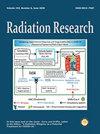聚乙二醇G-CSF与环丙沙星联合治疗可通过增加AKT激活而降低IL-18、C3和miR-34a来减轻致死性电离辐射对骨髓、脾脏和回肠的损伤。
摘要
发现环丙沙星(CIP)可将聚乙二醇化G-CSF治疗(PEG, Neulasta®)诱导的电离辐射暴露后存活率从30%提高到85%。这种联合治疗通过其改善血小板恢复的能力显著减轻了辐射引起的脑出血。这项研究测试了这种联合治疗是否也减轻了辐射对胃肠道的损害。B6D2F1雌性小鼠暴露于60Co γ辐射。每天给小鼠喂食CIP,持续14天。第1天注射聚乙二醇,然后每周注射一次,直到第14天。在早期时间点研究中,于放疗后第2、4、9和15天采集血液、股骨、脾脏和回肠。骨髓细胞计数;测定脾脏重量和脾细胞计数;并进行回肠组织病理学检查和分析。采用Western blotting检测回肠裂解液中AKT、ERK、JNK、p38、claudin 2、NF-kB、Bax、Bcl-2和gasdermin D的含量,采用反转录法和实时pcr检测miR-34a含量,采用比色法检测瓜氨酸含量。采用Luminex法检测血清中白细胞介素-18 (IL-18)含量,ELISA法检测补体蛋白3 (C3)含量。实时荧光定量PCR检测肝脏细菌DNA负荷。放疗后第2天至第15天,辐射使股骨骨髓细胞减少,PEG或CIP+PEG分别在第9天至第15天减轻,CIP在第15天减轻。辐射暴露导致脾脏重量在第2天至第15天下降,而PEG或CIP+PEG在第9天至第15天显著减轻了脾脏重量的下降。放射暴露在放射后第2天至第15天减少了脾细胞计数,但在第15天使用PEG或CIP+PEG可以减轻这种情况。回肠组织学显示,第2 ~ 15天,放射线使回肠绒毛高度降低;CIP在第15天减轻了这种减少,而PEG+CIP在第2天至第15天减轻了这种减少。第2 ~ 15天绒毛宽度增加,而PEG+CIP在第4 ~ 15天有效减小绒毛宽度。在第2天,放疗减少了隐窝深度,但在第4至15天恢复到基线。CIP或CIP+PEG仅在第4天瞬间增加深度。放疗后第2天和第4天隐窝计数减少,但在第9天和第15天恢复到基线水平,无论单独用药或联合用药。瓜氨酸数据证实了绒毛高度的恢复。放疗在第4天和第9天显著增加促炎细胞因子IL-18, PEG单独或PEG+CIP均能减轻这一作用,而CIP单独则不能。放疗使第9天回肠和血清中C3含量升高。血清C3与血清IL-18水平呈正相关,与隐窝深度呈负相关。辐射引起的回肠中claudin 2(一种紧密连接标记物)的减少和肝脏中细菌DNA的增加被PEG+CIP减轻。放疗没有降低NF-kB及其活化,但降低了Bcl-2的表达,任何单一药物或联合药物都无法显著恢复。然而,PEG和CIP联合显著降低NF- kB和BAX。相比之下,辐射增加了miR-34a和裂解的气皮蛋白D,而CIP+PEG有效地缓解了这一点。免疫组织化学证实了这一点。综上所述,PEG+CIP联合治疗可有效减轻放射诱导的骨髓、脾脏和回肠损伤。这种联合治疗的缓解作用是通过抑制miR-34a的G-CSF水平的增加介导的,从而可能导致气皮蛋白d介导的焦亡减少。Ciprofloxacin (CIP) was found to enhance pegylated G-CSF therapy (PEG, Neulasta®)-induced survival from 30% to 85% after ionizing radiation exposure. This combined therapy significantly mitigated radiation-induced brain hemorrhage through its capability to improve platelet recovery. This study tested whether this combined treatment also mitigated gastrointestinal damage from radiation. B6D2F1 female mice were exposed to 60Co γ radiation. CIP was fed daily to mice for up to 14 days. PEG was injected on day 1, and then weekly up to day 14. For the early time point study, blood, femurs, spleen, and ileum were collected on days 2, 4, 9, and 15 postirradiation. Bone marrow cells were counted; spleen weights and splenocyte counts were measured; and ileum histopathology was examined and analyzed. AKT, ERK, JNK, p38, claudin 2, NF-kB, Bax, Bcl-2, and gasdermin D were measured in ileum lysates using Western blotting while miR-34a was measured by reverse transcription followed by real-time-PCR, and citrulline was measured by colorimetric assay. In serum, interleukin-18 (IL-18) was measured by Luminex assay and complement protein 3 (C3) was detected by ELISA. The bacterial DNA load in livers was measured by real-time PCR. Radiation depleted bone marrow cells in femurs beginning day 2 through day 15 postirradiation, which was mitigated by PEG or CIP+PEG on day 9 through day 15 and by CIP on day 15, respectively. Radiation exposure led to decreased spleen weight on day 2 through day 15, while PEG or CIP+PEG significantly mitigated the reduction on day 9 through day 15. Radiation exposure reduced splenocyte counts on day 2 through day 15 postirradiation, but that was mitigated by PEG or CIP+PEG on day 15. Ileum histology showed that radiation decreased villus height on day 2 through day 15; CIP mitigated the reduction on day 15, whereas PEG+CIP mitigated it on day 2 through 15. Villus widths were increased on day 2 through day 15, while PEG+CIP effectively decreased them on day 4 through day 15. Crypt depth was reduced by radiation on day 2, but returned to the baseline on day 4 through 15. CIP or CIP+PEG transiently increased the depth only on day 4. Crypt counts were reduced by radiation on days 2 and 4, but returned to the baseline on days 9 and 15, regardless of individual drugs or combinations. Citrulline data confirmed the villus height recovery. Radiation significantly increased pro-inflammatory cytokine IL-18 on days 4 and 9, which was mitigated by PEG alone or PEG+CIP, but not by CIP alone. Radiation increased C3 on day 9 in ileum and serum. The serum C3 was positively associated with the serum IL-18 levels and negatively correlated with the crypt depth. Radiation-induced decreases in claudin 2 (a tight junction marker) in ileum and increases in bacterial DNA in livers were mitigated by PEG+CIP. Radiation did not reduce NF-kB and its activation but reduced Bcl-2 expression, which was not significantly recovered by any individual drug or combination. However, the PEG and CIP combination significantly decreased NF- kB and BAX. In contrast, radiation increased miR-34a and cleaved gasdermin D, which CIP+PEG effectively mitigated. This was confirmed by immunohistochemistry. The results taken together suggest that PEG+CIP combined treatment was effective in mitigating the radiation-induced bone marrow, spleen, and ileum injury. The mitigative effect of this combined treatment was mediated by increases in G-CSF levels that suppress miR-34a, thereby probably leading to decreased gasdermin D-mediated pyroptosis.

 求助内容:
求助内容: 应助结果提醒方式:
应助结果提醒方式:


